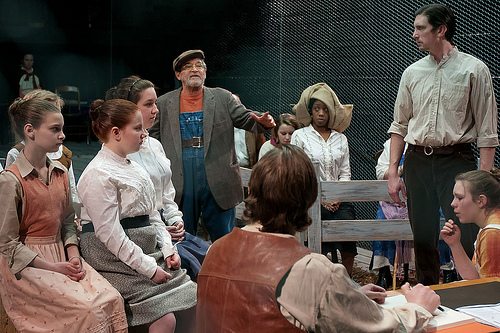
(l. to r.) Cassie Van Druff, Hannah Paczkowski, Maggie Swahl, Paul Fein, Jeff Hunsicker, Ali Dougherty, Titilola Verissimo, Bob Stineman, Molly Lang in a scene from THE CRUCIBLE, playing at Tri-County Performing Arts Center in Pottstown PA through March 20.
Like many people, I was introduced to THE CRUCIBLE in a high school English class. The teacher dutifully told us that it was a play about McCarthyism and the House Un-American Activities Committee. But it’s not. Though deeply allegorical, Arthur Miller’s classic is “about” the Salem witch trials of the 1690s: it follows the interpersonal and political dynamics behind the accusations of witchcraft by several young girls against fellow members of their New England Puritan community. For the play to succeed it has to work at face value, and the allegories it contains must seem relevant today, long after the spectre of communism and the paranoia it provoked have passed.
These demands are handled with varied success in the production of THE CRUCIBLE now onstage at the Tri-County Performing Arts Center in Pottstown, PA. Director John Moletress made the unfortunate decision to situate the action in the 1950s, but apart from some period radio excerpts, this too-obvious relocation is not distractingly sustained. Soon, an elegantly convincing set (Kevin Jordan) and Miller’s poetic Jacobean language transport us to the isolation of a rural colonial society.
Moletress won multiple awards in his hometown Washington, DC, for his direction of 4:48 Psychosis, a challenging experimental work by Sarah Kane, whose brutal first play, Blasted, recently took the Philadelphia theater world by storm. Moletress has clearly incorporated tools of modern performance art into his repertoire, with a creative use of set design, lighting (Dan McDonough), and popular music more often seen in experimental dance shows than local productions of classic plays. With a combination of imaginative decisions, Moletress gives the production a distinctly contemporary feel.
THE CRUCIBLE is often staged in the round, and indeed a three-sided theater in Sheffield, England, (also home to the world championship of snooker, a popular form of billiards), takes its name from the play and opened with a production of the work. For Moletress’s production, the seats in Tri-County’s flexible space are arranged in three symmetrical rows on either side of a long central stage.
Although at times it makes for neck-stretching viewing, the en face seating brings the audience solidly into the action. Seeing fellow viewers across the stage reinforces the public nature of the performance and invites us to participate in the judgment of the accused “witches” with the townspeople of Salem.
This arrangement might make for an endearingly intimate viewing experience, except Moletress and Jordan have forcibly separated us from the action by erecting chicken wire barriers the lengths of both sides of the stage. For much of the performance, this physical obstruction is a distraction and a visual inconvenience, but it is used to great effect at key moments in the play. It is most poignant in the final scenes, when several accused “witches” are enclosed in wire cages. I had grown to think that the boundary trapped Salem’s townspeople in their own closed community, but the presence of these additional cages forced me instead to identify with their occupants. Is it the audience who are fenced in, accused?
A varied lighting scheme also adds to the production’s flavor. Courtroom scenes are lit by overhead neon lights, putting both the judged and the judges under an abrasive glare. The play’s climax is set just before dawn, hours before the flawed hero, John Proctor (Bob Stineman), is set to be hung for witchcraft. Orange-tinted spotlights provide scant illumination, adding an eerie depth to the scene.
The music choices, too, contemporize the play, with strains of Radiohead, Johnny Cash’s cover of “Hurt,” and other modern songs caressing the action. The soundtrack is most effective when a character mimes a screeching Siouxsie and the Banshees song, “Eve White/Eve Black,” pleading “Get me out of here, I belong out there,” in the production’s frantic climax.
The long stage allows for some beautifully choreographed movement and placement and a full ensemble of nearly two dozen actors move and interact with fluidity, although performances were somewhat inconsistent on opening night. Apparently, a couple members of the cast left the production just days before the run began; that I was unable to discern which parts were substituted is both a tribute to their substitutes and a critique of the overall ensemble.
Several actors did stand out. Stineman holds the show together with a consistently solid portrayal of a troubled John Proctor and Andrea Frassoni is equally strong as his suffering wife Elizabeth. In smaller roles, Susan Giddings gives a nuanced performance as Ann Putman and the splendidly named Titilolo Verissimo shines as the Barbadian slave Tituba, even if her powerful emotion does sometimes tread into shrillness.
In the end, the issues raised by Miller in the early 1950s remain as relevant today as in 1690. Several themes are emphasized in this production: the use of fear to exert authority, the dangers of isolated thinking, and the the ease with which reason can be usurped by irrationality.
At its best — in a dramatic courtroom confrontation and in a moving, frenetic, and imaginatively staged final scene — this production breathes fresh life into a classic of the American stage. Moletress and Tri-County deserve praise for their bold take on the play, even if not all of their decisions are wholly effective.
THE CRUCIBLE
By Arthur Miller
Directed by John Moletress
March 3–20, 2011
Tri-County Performing Arts Center
245 E. High Street
Pottstown, PA
610-970-1199
www.tripac.org

